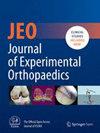Lateral extra-articular tenodesis improves functional movement outcomes in ACL reconstruction patients
Abstract
Purpose
The primary aim was to evaluate the functional impact of adding lateral extra-articular tenodesis (LET) to an anterior cruciate ligament (ACL) reconstruction (ACLR). The secondary aim was to assess whether LET provides benefits in muscle strength, patient-reported outcome measures (PROMs) and return to sport (RTS) pass rate, as well as to examine the influence of meniscal injury on performance in ACLR patients.
Methods
A retrospective cohort of prospectively collected data on all ACL procedures was performed at AZ Delta Roeselare between 2017 and 2019. The patients followed a 7-month rehabilitation programme and were assessed according to standardised RTS criteria. Patients were divided into two groups according to whether they received LET technique or not, and then each group was further divided based on the presence or absence of meniscal injury. The primary outcomes were the functional movement tests including agility t-test and hop tests. The secondary outcomes were the muscle strength, PROMs and RTS pass rate. A two-way ANCOVA test or a non-parametric test was used to investigate clinical and functional differences among the four groups.
Results
A total of 105 ACL injury patients who underwent ACLR with or without LET were included. The cohort consisted of 74 males and 31 females, with an average age of 25.0 ± 6.2 years. Significantly statistical differences among groups were found for the functional movement tests at 7 months post-operatively in favour of the ACLR with LET groups compared with isolated ACLR groups (agility t-test: 95% confidence interval [CI] 0.3–1.2, p = 0.003; cross-over hop test: injured leg: 95%CI 20–86, p = 0.002; uninjured leg: 95%CI 12–76, p = 0.008; triple hop test: injured leg: 95%CI 7–77, p = 0.019). There were no significant differences in muscle strength, PROMs or RTS pass rates among the groups. Meniscal injury had no significant effect on any variable of interest.
Conclusion
The addition of a LET procedure to an ACLR showed important improvements in functional movement outcomes at 7 months post-operatively with no negative effect on muscle strength or PROMs.
Level of evidence
Level III.

 求助内容:
求助内容: 应助结果提醒方式:
应助结果提醒方式:


